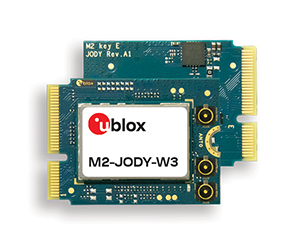
u-blox is introducing a set of Wi-Fi 5, Wi-Fi 6 and Bluetooth expansion cards that plug into NXP Semiconductors’ i.MX processor evaluation kits. The cards, which conform to the M.2 form factor, integrate u-blox modules powered by wireless SoCs from NXP Semiconductors.

“NXP is committed to accelerating the widespread adoption of Wi-Fi 6 and by collaborating with module partners like u-blox, we are making it easier and faster for developers to design smart connected devices that also leverage the power of our embedded processors,” said Jay White, senior marketing manager of mass market for Wi-Fi solutions at NXP. “These new cards from u-blox leverage our highly integrated 88W8987 and 88Q9098 Wi-Fi 6 + Bluetooth chipsets and easily plug into the M.2 sockets of our i.MX evaluation and development kits, making it significantly easier for developers to explore the many wireless connectivity possibilities enabled by their modules.”
u-blox is launching two wireless-connectivity cards based on its JODY modules. The cards are built to the M.2 Type 2230 Key E form factor, for which sockets are provided on the latest range of NXP i.MX evaluation boards.
The M2-JODY-W3 card comprises a u-blox JODY-W3 Wi-Fi 6 and Bluetooth 5.1 module. The module’s NXP 88Q9098 chipset supports IEEE 802.11ax and dual-mode Bluetooth 5.1. It runs concurrent dual-band Wi-Fi 2,4 GHz and 5 GHz networks using dual MACs and a 2x2 MIMO antenna set-up in each band. Bluetooth support includes dual-mode Bluetooth 5.1 Classic and LE, as well as the standard’s long-range operation option. The M2-JODY-M3 card supports simultaneous operation of Wi-Fi and Bluetooth. Its Wi-Fi functionality includes simultaneous access point, station or Wi-Fi Direct modes.

The M2-JODY-W2 card features a u-blox JODY-W2 Wi-Fi 5 and Bluetooth 5 module, which uses the NXP 88W8987 chipset to support IEEE 802.11ac and Bluetooth/Bluetooth Low Energy 5. The card supports dual-band Wi-Fi to the 802.11a/b/g/n/ac standards. As with the M2-JODY-W3 card, the M2-JODY-W2 supports dual-mode Bluetooth 5 operation. The card is capable of dual-port simultaneous operation of Wi-Fi and Bluetooth and its Wi-Fi functionality also includes simultaneous access point, station or Wi-Fi Direct modes.
These new cards can be used as a way of evaluating wireless connectivity options in the context of both NXP i.MX evaluation kits and embedded system boards built by NXP partners. Use cases for these highly functional parts may include industrial automation, vehicle navigation and telematics, in-vehicle infotainment and hands-free audio, remote diagnostics and patient monitoring, security cameras, payment terminals and other applications requiring high data rates.
To enable the use of the M2-JODY-W3 and M2-JODY-W2 cards with legacy evaluation boards that do not feature an M.2 socket, u-blox offers a convenient microSD-to-M.2 adaptor that connects to a standard microSD socket, or a microSD-to-SD adaptor for boards with a standard SD socket.
| Tel: | +27 21 555 8400 |
| Email: | [email protected] |
| www: | www.rfdesign.co.za |
| Articles: | More information and articles about RF Design |
© Technews Publishing (Pty) Ltd | All Rights Reserved